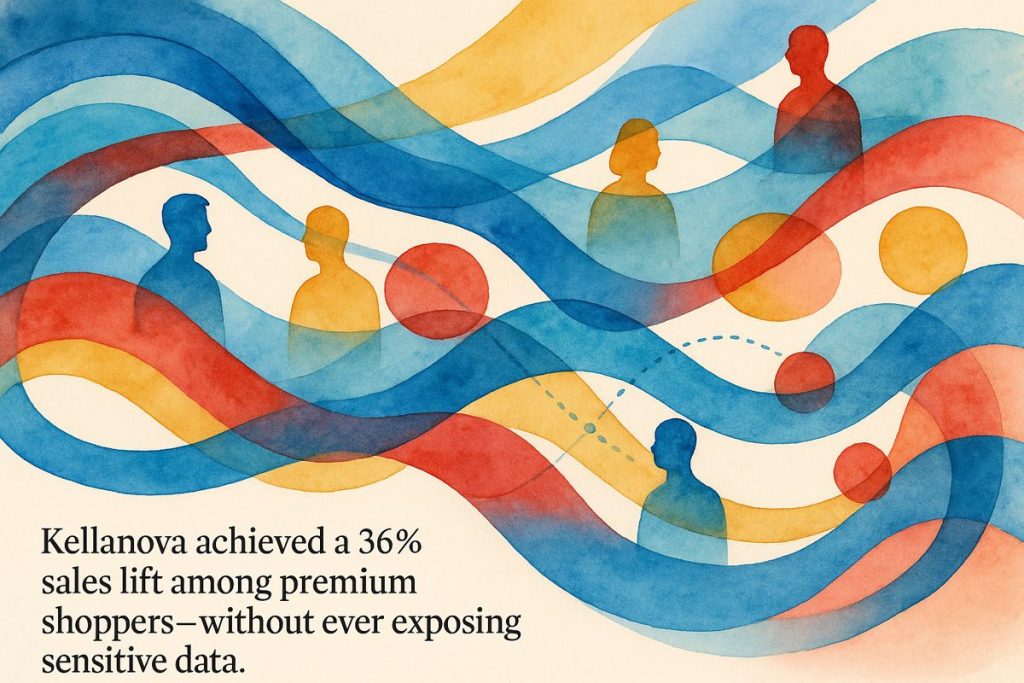Kellanova was facing falling Special K cereal sales in the UK, so they used a special tool called a data clean room to mix data from different sources without breaking privacy rules. This let them see which groups of shoppers really wanted their cereal, so they could send the right ads to the right people. Thanks to this smart targeting, Special K sales jumped by 36% among premium shoppers, and the company made millions more in sales. The key was focusing on solving the real problem, not just using new technology for its own sake, and being flexible when things got tricky. This new way of working helped other brands in the company succeed, too.
How did Kellanova use data clean rooms to boost Special K sales in the UK?
Kellanova leveraged Snowflake’s data clean room to securely combine Circana and Experian data, enabling precise audience segmentation without compromising privacy. This targeted marketing approach increased Special K sales by 36% among premium shoppers and improved media efficiency, resulting in millions in incremental sales.
The Cereal Slump and a Riddle Wrapped in a Data Enigma
Picture this: it’s January, and the Special K team at Kellanova are huddled over mugs of harsh, office-grade coffee, noses twitching at the lingering scent of burnt toast. The United Kingdom’s cereal aisle has become a battleground, but not the glorious kind that inspires cheeky TV adverts. No, sales are slipping—Special K, that decades-old stalwart, is suddenly looking, well, a little long in the tooth. The numbers say it all: a disquieting dip in market penetration, and a price tag a whopping 145% above the category average, which is about as subtle as a foghorn at dawn. Oof.
Now, here’s the rub. Do you chase shiny tech for the sake of it—a temptation as irresistible as a third donut—or do you let the business problem lead you by the nose? Louise Cotterill, Kellanova’s head of insights, has been burned by “tech-first” initiatives before. “If you start with the technology, it will never land and never get embedded in the business,” she told her team (and, incidentally, Marketing Dive). I had to stop and ask myself: why do so many companies get this backwards? Maybe it’s the siren song of buzzwords; maybe it’s just hubris. I’ve certainly fallen for it in the past—there was that one time with the blockchain dashboard for a bakery chain. It did not end well.
Clean Rooms: More Than a Buzzword, Less Than a Magic Wand
Enter the Snowflake Data Clean Room—a tool that, despite sounding faintly like something you’d find in a hospital, is fast becoming the darling of privacy-wary marketers everywhere. But what is it, really? Imagine a neutral chamber, secured with digital deadbolts and lined with hyperspectral sensors (okay, maybe not literally), where you and your partners can mingle datasets without ever letting raw, juicy details slip across the divide. No names, no emails, no chance for the privacy police to barge in waving GDPR fines. For Special K, this meant marrying postcode-level Circana data with (wait for it) 20 million addressable records from Experian, all without so much as a whiff of personal data changing hands. It’s like conducting a symphony while everyone’s wearing noise-cancelling headphones—complex, precise, and, oddly, a bit exhilarating.
The upshot? Kellanova’s marketing team could finally see their audience not as a shapeless blob, but as a galaxy of micro-segments: loyalists who just needed a nudge, value-chasers who pounced on deals, and the ever-elusive new recruits. One morning, as I watched the dashboards flicker with real-time results, I’ll admit—I felt a jolt of satisfaction. Was it… excitement? Relief? Maybe a bittersweet mix of both. There’s nothing quite like seeing a plan come together, even if the air conditioning is broken and the coffee tastes like regret.
From Guesses to Granularity: Real Results, Not Just Vibes
So, what did all this data alchemy yield? Numbers that even the most cynical spreadsheet-warrior would find hard to ignore. Among premium shoppers, sales jumped by 36%. That’s not a rounding error; that’s a parade. Price-conscious buyers? Up 9%. The real kicker: a 1–2% bump in media efficiency, which, at Kellanova’s scale, translates to “millions in incremental sales” (as Chief Growth Officer Charisse Hughes told Consumer Goods). It’s the marketing equivalent of finding a five-pound note in your winter coat, except the coat is the size of the United Kingdom.
What sticks with me is the way creative could be tailored—one message for the loyal, a nudge for the deal-seekers, all deployed seamlessly across Meta and YouTube. No more carpet-bombing with generic ads. Instead, each campaign landed with the precision of a chess grandmaster’s endgame maneuver. Of course, there were hiccups. Early on, the integration with Experian’s datasets felt like assembling IKEA furniture with the wrong manual. There was a moment I wondered if we’d ever get it right. We did—eventually.
Lessons Learned: Focus, Fails, and Why Clean Rooms Aren’t Plug-and-Play
Let’s not sugarcoat it: data clean rooms aren’t a panacea. Each deployment is a palimpsest of old habits, regulatory quirks, and, sometimes, outright confusion. Privacy laws dance like will-o’-the-wisps across jurisdictions—what works in Manchester might get you a sternly worded letter in Munich. There’s a lesson in that: flexibility isn’t just nice to have, it’s the coin of the realm.
Kellanova did two things right. First, they started with the problem, not the tech. That sounds obvious, but it’s as rare as a quiet Slack channel on launch day. Second, they embraced a bit of chaos—experimenting, failing fast, adjusting course, and sharing learnings across brands. After Special K’s turnaround, the clean room playbook rolled out to Pringles, Cheez-It, and beyond. Remember the Pringles x Crocs drop? 1.6 billion impressions, product gone in 90 minutes. Or the Pringles x Caviar Co Tik
